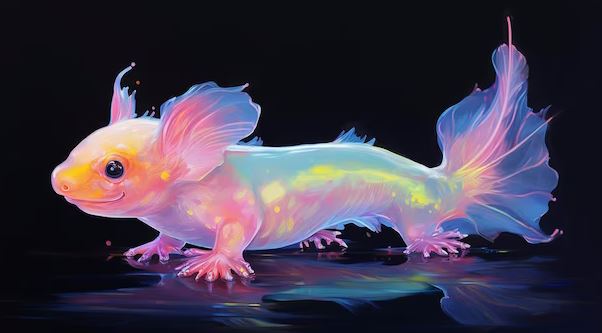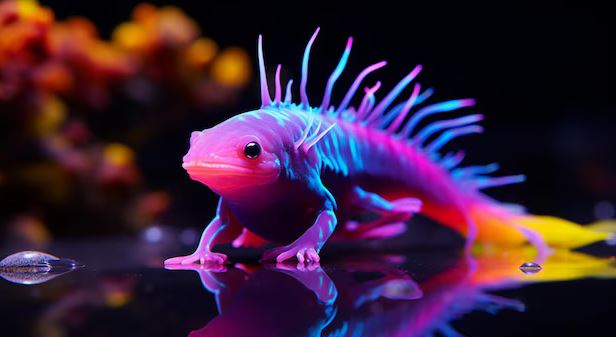Introduction to the Blue Neon Axolotl
If you’re captivated by creatures that seem to belong in a fantasy realm, the Blue Neon Axolotl is sure to steal your heart. With its vibrant blue hue and whimsical appearance, this enchanting amphibian stands out as one of nature’s most extraordinary beings. Imagine a pet that not only looks stunning but also boasts an intriguing backstory and unique personality traits. Whether you’re a seasoned aquarist or just beginning your journey into aquatic pets, understanding the allure of the Blue Neon Axolotl will add more excitement to your experience. Let’s dive deeper into what makes these captivating creatures so special!
History and Origins of the Blue Neon Axolotl
The Blue Neon Axolotl is a captivating twist on the traditional axolotl. This mesmerizing creature has its roots in Mexico, specifically tied to the ancient lakes surrounding Mexico City.
Historically, axolotls were revered by the Aztecs for their unique appearance and regenerative abilities. The blue neon variant emerged through selective breeding, highlighting vibrant colors that mesmerize enthusiasts.
As aquarists sought to enhance aesthetics, breeders focused on manipulating genetic traits. The result? A stunning palette of blues that glows under certain lighting conditions.
This striking coloration not only adds visual appeal but also sparks curiosity about genetics and environmental adaptations among hobbyists and researchers alike.
Today, the Blue Neon Axolotl stands as both an emblem of aquatic beauty and a testament to human ingenuity in pet breeding practices.
Physical Characteristics and Features
The Blue Neon Axolotl is a breathtaking spectacle of nature. Its vibrant blue hue stands out against the typical greens and browns of aquatic environments. This coloration results from selective breeding, making it a popular choice among enthusiasts.
These creatures have distinct external gills that resemble feathery plumes. These striking features not only enhance their appearance but also aid in respiration.
Their bodies are elongated and smooth, typically reaching lengths of about 9 to 12 inches when fully grown. The skin texture is soft, often giving a glossy sheen under natural light.
Each Blue Neon Axolotl has unique patterns and shades, adding to its charm. Their large eyes convey an innocent curiosity as they explore their surroundings, contributing further to their allure in the aquarium trade.
Habitat and Care Requirements for Blue Neon Axolotls
Creating the perfect habitat for a Blue Neon Axolotl is crucial for its health and happiness. These aquatic creatures thrive in cool, clean water with temperatures between 60°F to 68°F. A well-maintained aquarium is essential.
Aquariums should ideally be at least 20 gallons to provide ample space. Include a gentle filter that won’t create strong currents, as axolotls prefer calm waters. Use substrate like sand or smooth gravel to prevent injury during their exploration.
Lighting is important but keep it dim; bright lights can stress them out. Live plants offer hiding spots and enhance the environment without overwhelming your axolotl.
Regular water changes—around 20% every week—help maintain optimal conditions. Monitor pH levels between 6.5 and 7.5, ensuring safe surroundings for these unique pets.
Feeding requires attention too; high-quality pellets or live foods will keep your Blue Neon Axolotl vibrant and full of energy!

Breeding and Genetics of Blue Neon Axolotls
Breeding Blue Neon Axolotls can be a fascinating endeavor for enthusiasts. These vibrant creatures come from selective breeding of the wild-type axolotl and specific genetic lines that enhance their blue neon hue.
When mating, it’s crucial to select healthy parents with desirable traits. This ensures that offspring inherit the stunning coloration and good health characteristics. Genetic variations play a significant role in determining these traits, including patterns and shades of blue.
The process typically involves placing the female and male in a breeding tank together. After spawning, it’s essential to remove the adults to protect the eggs or larvae from being eaten.
Understanding genetics is key for those looking to refine their line further. Tracking lineage helps predict potential outcomes for future generations, contributing to more breathtaking colors or markings over time. Patience is vital; good things often take time to manifest in this captivating hobby.
Common Health Issues and How to Care for Sick Axolotls
Blue Neon Axolotls, like all aquatic creatures, can face health challenges. Being aware of common issues is crucial for their well-being.
One prevalent problem is fungal infections, often appearing as white spots or fuzzy patches on the skin. Maintaining clean water and ensuring proper tank conditions can help prevent this.
Another concern is swim bladder disorder, which affects buoyancy and swimming ability. If your axolotl seems to struggle while swimming or floats uncontrollably, a diet adjustment may be in order; consider including more fiber-rich foods like earthworms.
Moreover, monitor for signs of stress such as color fading or excessive hiding. Stress management includes maintaining stable water temperatures and avoiding overcrowding in the tank.
Keep an eye out for any unusual behaviors or changes in appetite too. Early detection makes a significant difference when addressing health issues effectively.
Fun Facts About Blue Neon Axolotls
Blue Neon Axolotls are not just visually stunning; they come with some fascinating traits. These unique creatures are a type of salamander that retains their juvenile features throughout their lives, a phenomenon known as neoteny.
This incredible ability extends to other body parts, including parts of their heart and even portions of the brain.
Their vibrant blue hue is due to selective breeding, making them popular among hobbyists and collectors alike. While wild axolotls typically sport earthy tones for camouflage, the blue neon variety stands out in any aquarium setting.
Another fun fact: Blue Neon Axolotls have gills that resemble feathery plumes. They use these external gills for respiration underwater while also absorbing oxygen through their skin a remarkable adaptation.
Where to Buy Blue Neon Axolotls and How
If you’re captivated by the enchanting Blue Neon Axolotl and ready to bring one into your life, there are several avenues to explore. First, consider reputable aquarist shops that specialize in exotic pets. These establishments often have knowledgeable staff who can guide you on proper care.
Online marketplaces also offer a wide selection of Blue Neon Axolotls. Websites dedicated to aquatic pets frequently list these striking creatures for sale. Ensure the vendor has positive reviews and provides detailed information about their breeding practices.
Before purchasing, be mindful of the axolotl’s needs. Take time to prepare your aquarium environment with appropriate filtration, substrate, and water conditions. This ensures a smooth transition for your new pet.
When selecting an axolotl, observe its activity level and overall health. A vibrant blue hue is ideal! Always ask questions if you’re uncertain about anything related to care or genetics.
With careful consideration and preparation, welcoming a Blue Neon Axolotl into your home can be an incredibly rewarding experience filled with beauty and fascination.
